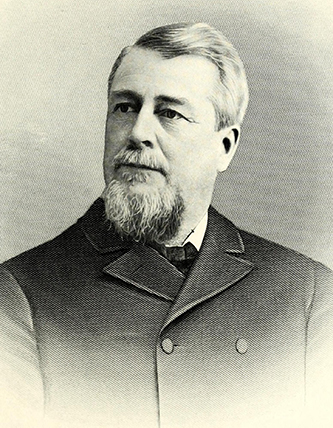July 19, 1839–April 21, 1900

Roger Moore, politician, Confederate officer, and Wilmington Coup collaborator was born in Wilmington. He was the son of Roger and Ann Sophia Toomer Moore. He was a descendant of James Moore, colonial governor of South Carolina and of "King Roger" Moore, founder of Orton plantation. In 1871, he married Susan Eugenia Beery, the daughter of Captain Benjamin Beery of Wilmington. They were the parents of nine children, seven of whom survived infancy. Their names were: Anne, Parker Quince, Henry Roger, Edwin Yeamans, Robert Jefferson, Louis Toomer, and Mary Ella.
In the spring of 1862, Moore entered military service as a member of Laurence's Partisan Rangers. He was subsequently assigned to the Third North Carolina Cavalry of the Confederate Army. When Laurence's rangers were divided into two companies, Moore was promoted to captain. He commanded the second company and was subsequently made commissary of the Third Cavalry. A year later, he was promoted to major and in 1864 to lieutenant colonel. Moore was already serving as commander of the regiment following the capture of Colonel John A. Baker. While with the Third Cavalry, Moore participated in the battles of Kinston and New Bern. He also served with General James Longstreet in the Suffolk area. In total, Moore’s Civil War service record includes approximately twenty-three encounters with Union forces.
After the surrender at Appomattox, Moore returned to Wilmington. There, he became a grocer and worked in the grocery industry. Moore then went into the brokerage business and became the agent for Paterson, Dawning, and Company. Moore also opened a building supply firm called Roger Moore Sons Company.
Moore was considered a community leader in Wilmington, even at the young age of thirty. His service with the Confederate Army during the Civil War, along with his business ventures in the city, supported his status. This reputation helped Moore to become a leader of the Ku Klux Klan in Wilmington. He “considered the Klan a novel and necessary endeavor” to protect white interests in the South after the Civil War. Moore used his position as a major in the New Hanover County militia to recruit new members for the Klan. Prior to the election in 1868, Moore led Klan activity in Wilmington that focused on intimidating Black voters. The intimidation tactics included “little more than threatening notices and trying to frighten blacks with mysterious bones, skeletons, and skulls.” After the failure of these tactics, a lack of reported Klan activity in the area suggests that Moore was no longer involved with the society. This was not the end of voter intimidation in Wilmington or Moore’s involvement and leadership of such activities.
Moore ran for elected office in 1898 and joined the Democratic party’s political machinations before and during the Wilmington Coup of 1898. Prominent white families in the Wilmington area asked Moore to lead the “Vigilance Committee.” The Vigilance Committee was composed of groups of armed white citizens who patrolled the streets of Wilmington in anticipation of violence in the run-up to the election of 1898. Moore was also given the “title of chief marshal” of the “Red Shirts.” The Red Shirts were a white supremacy terrorist organization that focused on voter suppression and election tampering. Their main methods of interference were voter intimidation, coercion, and ballot box stuffing. Moore attended a formal Red Shirt rally in Wilmington on November 3rd, 1898.
During the Wilmington Coup, Moore, along with several other white Democrats, quelled violence against a group of unarmed Black laborers who worked for Sprunt Cotton Compress. Several white coup conspirators demanded that the workers be shot, claiming that they were out of control and needed to be shot to maintain order. Moore “warned that anyone who fired a weapon at the compress would be arrested.” Bloodshed at the compress was avoided as a result and the Black workers were escorted home to ensure their safety. Moore also helped prevent members of the Red Shirts from lynching some prominent Black citizens of the city who had been incarcerated in the local jail. Moore also used members of the Vigilance Committees as “checkpoints,” where Black residents were unlawfully searched as tensions in Wilmington continued to rise. Black voters and citizens of Wilmington had been wrongfully depicted as carriers of concealed weapons or as being a safety hazard to white voters. Moore conceded “command” of his Vigilance Committees to Walker Taylor. Taylor was a prominent Democrat and commander of the Wilmington Light Infantry. Governor Daniel Russell sent a telegram instructing Taylor to “preserve the peace” when violence in Wilmington against Black Americans reached its greatest point.
Moore was elected to the New Hanover Board of Commissioners in 1898 during the election cycle of the Wilmington Coup. His record of civil service also included roles as alderman of Wilmington, chairman of the New Hanover County Board of Commissioners, president of the Wilmington Produce Exchange, member of the board of directors of the Seaman's Friends Society, and chairman of the Board of Hospital Managers and of the county auditing board. He was also director of the Associated Charities, chief of the volunteer fire department, and chairman of the board of trustees of the YMCA. Moore was also a member of the Grace Street Methodist Church and was active in its congregation.
Moore “died suddenly of apoplexy” on April 21, 1900 at 11pm. He was sixty-two years old. He is buried at Oakdale Cemetery in Wilmington.